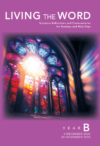Scripture Study for
Assumption of The Blessed Virgin Mary
Revelation 11:19a; 12:1–6a / Psalm 45:10bc / 1 Corinthians 15:20–27 / Luke 1:39–56
<< Back to LECTIONARY RESOURCES
Understanding the Word
By Br. John R. Barker, OFM
The reading from Revelation proclaims God’s final victory over the forces of evil and chaos that have threatened God’s creation since the days of the Garden of Eden. The woman who appears to John as a “great sign in the sky” represents Israel, not only the ethnic and historic Israel (symbolized by the twelve stars), but all of God’s people united in Christ. The image of the woman in labor represents both the actual birth of the Messiah and the pain and toil of giving birth to the reign of God in the end-times (Matthew 24:8; Mark 13:8; Romans 8:22; 1 Thessalonians 5:3). The image is apt, as the victory is not without cost. The great dragon is Satan, the agent of chaos and evil who seeks to destroy the Messiah’s reign of God but will be defeated (12:7–9), while the people of God remain firmly under the protection of God.
A central theme in Paul’s letters is the resurrection not only of Christ but also, eventually, of all the dead. Yet it appears that some in Corinth did not believe in the resurrection of Christ or of the dead in general. After showing that such a belief makes the gospel nonsense (15:12–19), Paul asserts again that not only was Christ raised from the dead, but he is “the firstfruits of those who have fallen asleep.” Death came to the human race through the sin of Adam; now life comes because of the obedience of Christ, whose sacrifice in our behalf has defeated death. As history moves toward its climax, those who belong to Christ and then others will be raised from the dead. In that final hour, Christ’s sovereign rule over all creation will be complete and evident, as even the greatest enemy of humans, death itself, is subjected to him.
Mary’s Magnificat exults in the work that God has done, still does, and will do for God’s creation. Not only has God looked upon Mary, “his lowly servant,” but by bringing forth the Messiah, God has looked with favor upon “all generations.” We note that Mary uses the “prophetic perfect” here: God “has” shown the strength of God’s arm, scattered the proud, filled the hungry, etc. One has only to look around to see that in many cases the proud and the rich do still reign, while the lowly and hungry still suffer. So how is it that God “has” accomplished this reversal? The prophetic perfect speaks from the perspective of God’s will, which is never thwarted and so will certainly come to pass. They are as certain to happen as if they already had. Mary’s song expresses this trust in God’s word, enlivened by the child in her womb, the clearest sign that God’s will is being done.
